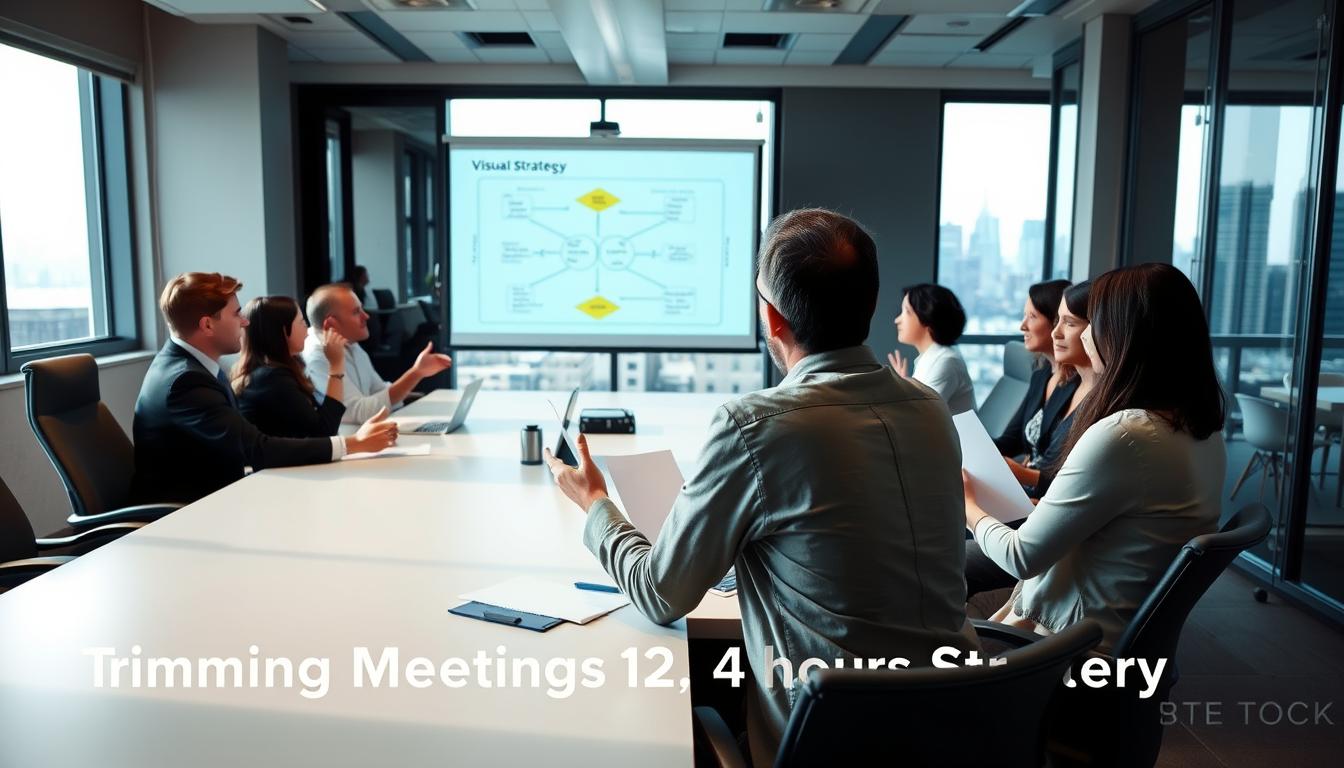In our fast-moving work world, it’s key for small teams to have a lean meeting culture. This helps boost productivity and teamwork. We will explore how to have effective meetings, the importance of making meetings work better, and strategies specially for small teams. These tips aim to push teams towards their goals.
Understanding Lean Meeting Culture
Lean meeting culture focuses on adding value and cutting out waste. It comes from lean management ideas used in the Toyota Production System. Making things better continuously and respecting everyone involved are key.
Key components include:
- Identifying non-value-added activities to eliminate distractions.
- Streamlining processes to enhance meeting efficiency.
- Optimizing team engagement, which strengthens collaboration during discussions.
Keeping these factors in mind helps organizations make meetings more productive. This adds to the overall value stream optimization. By getting rid of waste, meetings become more efficient. Teams can then focus on important goals.
The Importance of Effective Meetings in Small Teams
In small teams, having good meetings is key for clear talk and teamwork. These meet-ups are where decisions are made. They let everyone share news and agree on what to do next. Talking things through as a group helps tackle problems together, making the team work better.
To get more done, it’s crucial to make meetings work better. When meetings are well-planned and to-the-point, everyone can pitch in. This keeps spirits high and helps finish projects on time. Doing meetings right can mean the difference between success and getting stuck.
Creating a Lean Meeting Culture in Small Teams
Starting a lean meeting culture in small teams means using key lean ideas. These ideas aim to boost value while reducing waste and promoting ongoing improvement. By applying these ideas in meetings, teams create a productive and collaborative space.
Defining Lean Principles
Lean principles guide how small teams hold meetings. Important elements are:
- Ensuring each meeting has a defined purpose.
- Promoting active involvement from all team members.
- Consistently reviewing outcomes to improve future meetings.
Using these will lead to sharper talks, better participation, and a culture of constant betterment.
Benefits of Adopting Lean Practices
Embracing lean methods in meetings has many advantages:
- Streamlined conversations enhance value creation.
- It cuts down time and resource waste.
- Team members become more responsible.
Putting these methods into action boosts meeting efficiency and sparks a team-wide effort for continuous improvement.
Strategies for Streamlining Meetings
Successful meetings depend on using clear plans to stay focused. A well-planned agenda is key for keeping talks on track. It outlines the meeting’s goal, who needs to be there, and the topics to discuss.
Establishing a Clear Agenda
A good agenda has several important parts. It makes clear the meeting’s aim, who will attend, and what will be talked about. Setting a specific time for each topic helps keep the discussion from going off course. Sharing the agenda before the meeting helps everyone get ready and contribute effectively.
Setting Ground Rules for Participation
Guidelines for how to participate make meetings run smoother. Rules set how members should interact and share ideas. For instance, promoting active listening and polite interruptions helps include everyone. These norms help keep people involved and ensure everyone can help achieve the meeting’s goal.
The Role of Time Management in Meetings
Time management is key for great meetings. Being on time for meetings and ending them as planned shows we value time, boosting team productivity. It helps everyone respect each other’s schedules, leading to better focus and responsibility in the group.
Starting and Ending Meetings on Time
Starting and finishing meetings when we say we will shows we respect everyone’s time. It also helps us manage our time better. This way, team members can use their time well for other important work. It helps keep our work life balanced.
Implementing Time Limits to Maintain Focus
Setting time limits for agenda items helps keep discussions on track. Knowing there’s a time limit keeps everyone involved and attentive. This organized method improves how we manage time, making each meeting more successful and focused on our goals.
Encouraging Engagement and Participation
Making sure everyone on the team can share their ideas is key for group success. It’s important to create an environment where people are comfortable sharing their thoughts. This makes the conversation better and helps everyone work together better.
When people feel safe to express themselves, they bring new and creative ideas. This leads to better solutions and a stronger team.
Creating a Safe Space for Contributions
To make sure everyone feels included, it’s important to show that all ideas are welcome. You can:
- Ask questions that get everyone talking.
- Show that every idea matters to the group’s success.
- Make rules that focus on respect and listening to others.
These steps help everyone feel ready to share, which is important for team engagement.
Utilizing Strategies Like Round-Robin for Inclusivity
Using methods like round-robin can make sure everyone gets a turn to speak. This approach has great benefits:
- It ensures everyone contributes equally.
- It prevents louder people from taking over the conversation.
- It keeps the discussion lively and interesting.
By applying these methods, every team member gets to be heard. This boosts involvement and strengthens the sense of belonging, where everyone’s input is valued for the team’s success.
Leveraging Technology for Effective Meetings
Today, technology is key in making meetings work well. Virtual meetings get better with tools that help teams work together. These tools let people connect easily, no matter where they are. By using different virtual meeting tools, teams can talk and share ideas better.
Virtual Meeting Tools and Best Practices
Being good at using Zoom, Microsoft Teams, and Google Meet is important. These platforms have features that help everyone take part and keep things on track. To make your virtual meetings work best, try these tips:
- Set up cameras to enhance nonverbal communication.
- Encourage team members to mute their microphones when not speaking to minimize background noise.
- Utilize polls and Q&A sessions to gather instant feedback.
Using Collaborative Platforms for Pre-Meeting Preparation
Prepping for a meeting with collaboration tools can make a big difference. Tools like Trello, Slack, or Asana help share plans, assign tasks, and get thoughts from the team beforehand. This makes everyone ready to discuss, makes the meeting more useful, and ensures everyone is heard.
The Benefits of Daily Stand-Up Meetings
Daily stand-up meetings boost accountability. These quick meetings let everyone share their updates. This fosters transparency and support.
As team members talk about their work, they feel closer. This improves their work together and aligns the team better.
Encouraging Daily Accountability
Daily stand-ups make everyone more responsible. Knowing they’ll share progress, members are likely to finish tasks. They also help spot and solve problems early, keeping projects moving smoothly.
Fostering Improved Communication
Daily stand-ups keep everyone in the loop. By updating each other, the team stays aware of all tasks. This ensures all are working towards common goals, leading to success.
Utilizing Feedback for Continuous Improvement
Using feedback after meetings is key to improving small teams. It helps find where to get better and makes future meetings more effective. By checking in with team members, we learn what works and what needs to change. This leads to better ways to evaluate meetings.

Establishing a Feedback Loop Post-Meeting
To get everyone involved and open, set up a system for feedback. Here’s how:
- Distribute a short questionnaire after each meeting to gather impressions.
- Hold brief discussions where team members can share their thoughts on meeting structure and content.
- Encourage anonymous feedback to foster honesty and transparency.
Adapting Meeting Practices Based on Participant Input
Taking in what participants say can make your meetings better. Being flexible makes meetings more effective and meets team expectations. Teams can make changes and keep getting better by looking at feedback regularly.
Common Pitfalls to Avoid in Small Team Meetings
Small team meetings are a great chance for amazing teamwork. But, they can run into problems that stop everyone from being productive. Distractions often come up, hurting how much we can get done. Knowing what these problems are is the first step to making meetings better.
Recognizing and Addressing Distractions
It’s important to notice the distractions that can happen in meetings. Leaders can try different ways to stop these distractions:
- Minimize Phone Usage: Encourage people to keep their phones quiet or out of reach.
- Control Environmental Noise: Pick places that help everyone focus and keep outside noise low.
- Set Guidelines for Engagement: Make rules that help everyone pay full attention and join in.
Creating a space without distractions helps teams work better together. This makes the most of every meeting.
Avoiding Overly Long or Frequent Meetings
Too many meetings or ones that last too long can make people tired and less interested. This makes it hard to stay focused and be productive. Here are ways to help:
- Schedule Meetings Wisely: Don’t have too many meetings. Think about using email or a report instead.
- Set Duration Limits: Make sure everyone knows how long the meeting will be to stay on track.
- Implement Agenda Items: Make a list of what’s most important to talk about, to keep things useful.
Conclusion
When small teams adopt a lean meeting culture, they see big improvements in productivity and teamwork. Putting in place key practices helps make meetings useful. These include setting clear lean rules and ground rules.
Being good with time and getting everyone involved are also vital. They not only make meetings more effective but also build responsibility in the team. With focused teamwork, small groups can do more in less time. This greatly increases happiness and work output.
In the end, continuously getting better leads to lasting achievements. By often reviewing how meetings are run and asking for feedback, small teams can adjust and flourish. It might take a while to perfect a lean meeting culture. Yet, the benefits of better meetings and teamwork are definitely worth it.



